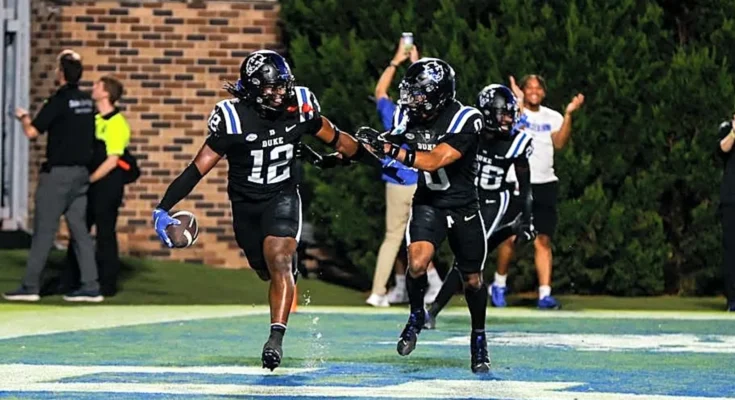Duke Football’s Dominant Front Seven in 2025 Earns Respect as Brian Parker II Calls It One of the Best
Duke football enters the 2025 season with something it hasn’t always been known for: a defensive identity built around one of the most powerful and disciplined front sevens in the ACC. For years, the Blue Devils were seen as a program that leaned heavily on offensive creativity to stay competitive, but the tides have shifted in Durham. Now, it is the defensive line and linebackers who are setting the tone, earning praise not just from coaches and analysts but from those who line up against them every day. Offensive lineman Brian Parker II, a veteran who has seen his share of battles in the trenches, has already called this group “one of the best,” a statement that speaks volumes about how far Duke has come in reshaping its roster, depth, and physical mentality.
To understand why this front seven has become such a focal point for Duke in 2025, it’s important to look at how the unit has been built. The Blue Devils have invested heavily in defensive line recruiting and development, securing high-motor defensive ends and powerful interior tackles who can both plug the run and collapse the pocket. What makes this unit stand out is its balance. There’s star power at the top, but there’s also rotational depth that ensures fresh legs and relentless pursuit late in games. Opposing offensive coordinators know they can’t just game-plan around one standout defender, because Duke has multiple players who can disrupt a drive at any given moment. That level of balance has been rare in Durham, but now it’s becoming a foundation of the team’s identity.
Brian Parker II’s comments carry weight because they reflect the daily grind of practice battles. Offensive linemen are often the first to recognize greatness in a defensive front. They feel the strength, speed, and technique up close, and they understand when an opponent across from them is operating at an elite level. For Parker to call Duke’s front seven “one of the best” is not just a casual compliment—it’s an acknowledgment of the collective growth and cohesion of a group that has embraced its role as the team’s engine. His praise also illustrates how iron sharpens iron, as the daily test of going against such a formidable defensive unit has forced Duke’s offensive line to raise its game as well. That competition in practice is already paying dividends, setting the stage for a more physical and disciplined team overall.
What makes this front seven particularly dangerous in 2025 is its versatility. On the defensive line, Duke can rotate between power rushers who collapse the pocket and agile edge defenders who can bend around tackles to pressure the quarterback. Inside, the tackles have shown a consistent ability to clog running lanes, demanding double teams and freeing up linebackers to fly to the ball. Speaking of linebackers, the group has grown into one of the most reliable and athletic corps in the conference. These aren’t just big hitters—they’re smart, instinctive players who excel at diagnosing plays and closing gaps before opponents can exploit them. They also bring speed to the field, giving Duke the ability to defend sideline to sideline in ways that previous rosters struggled with.
This evolution of Duke’s defense has also had a psychological effect on the team’s culture. For years, the Blue Devils had to embrace the underdog role, leaning on schemes to outsmart opponents who often had more raw talent. But now, with a front seven that can match up physically against the best in the ACC, Duke has a swagger that hasn’t always been present. They walk onto the field expecting to win battles in the trenches, and that confidence spreads throughout the roster. Defensive backs, for example, can play more aggressively knowing that the quarterback won’t have all day to throw. Offensive players, too, benefit from practicing against such a high-level unit, because it sharpens their skills for when they face other teams.
The impact of this defensive front is not just about limiting yards or sacks—it’s about momentum. Football games often turn on moments when defenses create havoc, forcing a punt, generating a turnover, or setting up the offense with favorable field position. Duke’s front seven has the potential to create those moments consistently, and that kind of presence changes the complexion of games. Fans who have watched the program’s rise in recent years understand that this is exactly the kind of foundation needed to compete at the highest level. Flashy offenses may capture headlines, but championships are built on the ability to control the line of scrimmage, and Duke is finally in that conversation.
Brian Parker II’s perspective also hints at the mutual respect that has developed between the offensive and defensive units. In many ways, the battles in practice are as tough, if not tougher, than those on Saturdays. That internal competition has pushed both sides of the ball forward, but it’s clear that the defensive front has become the standard-bearer. Parker’s recognition isn’t just praise—it’s motivation for the rest of the team. It signals that if Duke wants to take the next step, they’ll do it behind the force of a defense that refuses to back down.
The national perception of Duke football is also shifting. Analysts who once overlooked the program as an easy win are starting to acknowledge the talent being assembled, particularly on defense. Recruiting success has played a huge role, as Duke has managed to secure commitments from players who fit the mold of its new defensive identity. Player development has been equally important, with coaching staff refining raw potential into disciplined production. The result is a front seven that has both individual stars and a collective unity, a rare and potent combination in college football.
As the 2025 season unfolds, expectations for Duke’s front seven will only grow. Opposing quarterbacks will have to account for quicker decision-making, offensive lines will have to prepare for relentless pressure, and running backs will find fewer and fewer holes to exploit. That reality will make Duke a tough out for any opponent, even the traditional ACC powerhouses. What separates this group from past iterations is not just talent but consistency. It’s one thing to flash dominance in a few games; it’s another to bring that level of performance week in and week out. Duke’s front seven appears ready for the latter.
The cultural impact of such a defense goes beyond the field. Fans, alumni, and recruits alike are energized by a program that has found its identity in toughness and discipline. Highlight reels of sacks, forced fumbles, and goal-line stands create a narrative that Duke is no longer just a basketball school with a competitive football team—it’s a program capable of carving its own legacy on the gridiron. For young athletes considering their future, the chance to be part of a front seven like this is a compelling reason to choose Duke.
Brian Parker II’s simple yet powerful comment captures the essence of this transformation. Calling the group “one of the best” is not just hype; it reflects a reality that anyone watching closely can see. Duke football has built a defensive front that commands respect, and that respect is now turning into results on the field. As the season progresses, fans and analysts will have their eyes on this unit, waiting to see if they can sustain the dominance that has already defined their identity.
For Duke, the rise of its front seven represents more than just improvement—it’s a symbol of belief. Belief that the program can stand toe to toe with anyone, belief that physicality and discipline can win championships, and belief that the best days of Duke football are not behind them but ahead. With Parker’s endorsement echoing through the locker room, the Blue Devils know exactly who they are and what they’re capable of. And for the first time in a long time, their opponents know it too.



